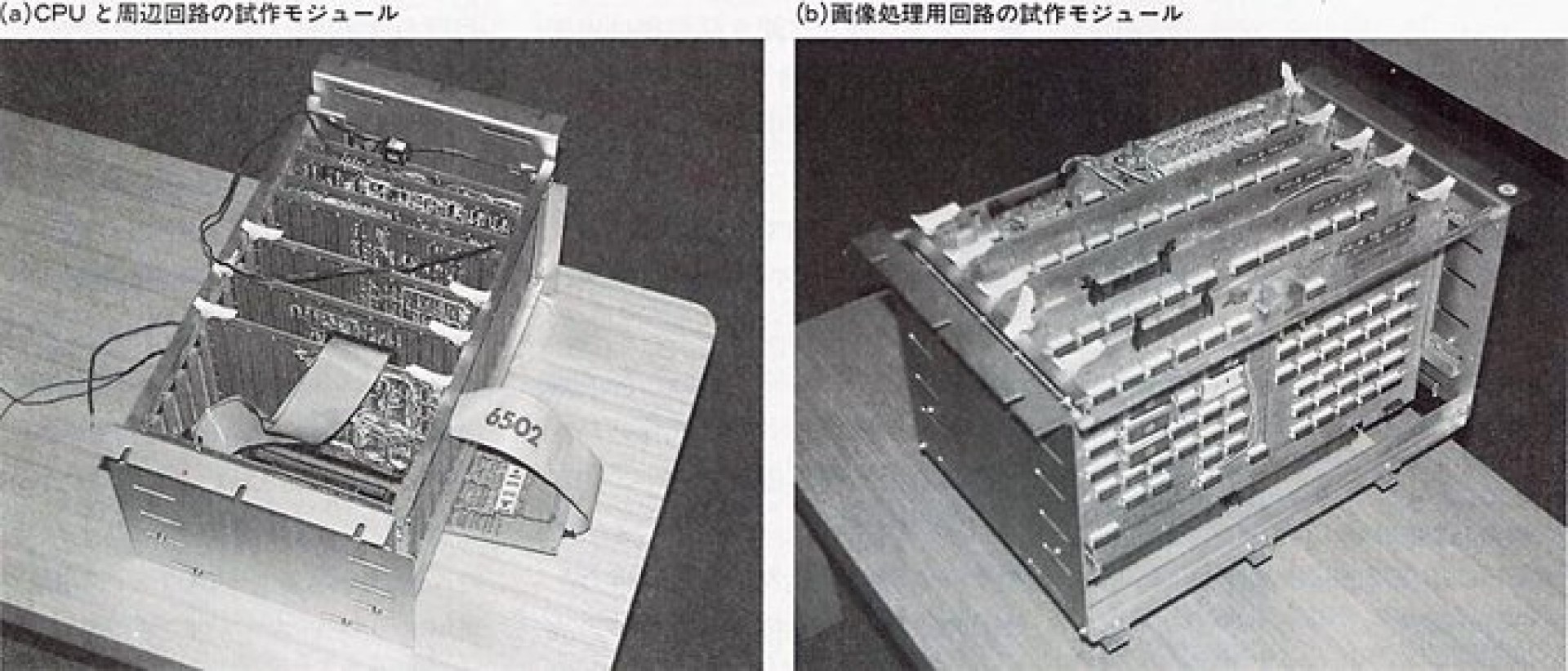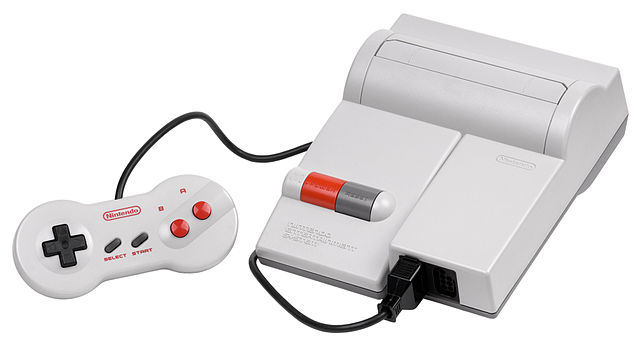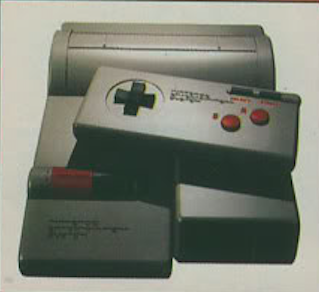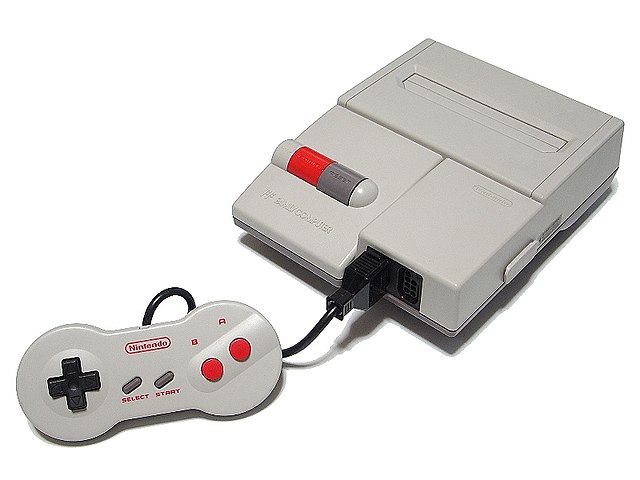After Nintendo's successful series of arcade games in the early 1980s, they decided to create a home console. The original plan
was to make a 16-bit computer package, including a keyboard and floppy drive. But, then-president of Nintendo Hiroshi Yamauchi
decided the console should be cartridge-based, arguing that keyboards and disk drives would intimidate non-tech-savvy consumers
(this revelation wouldn't last).

October 1982 saw the creation of a prototype to test the new architecture. This was when programming tools were created,
and games would start being coded. The codename for the system was "GameCom" (not to be confused with the touch-screen
handheld), but the wife of head of development Masayuki Uemura decided to call it the Family Computer, shortened to
Famicom.
Chief manager of the project Takao Sawano brought a ColecoVision to show to his family. They were amazed by its smooth
graphics compared to that of the slow and flickery Atari 2600. As for controller design, a joystick for movement was
planned. But Uemura felt that kids could step on and break them, so they became flat D-Pads, a consistent controller
design for decades to come.

On July 15, 1983, the Famicom was released and was slow to get up to speed. While 500,000 units were sold in the first
two months, some of the first revision units would glitch up and/or crash. The A and B buttons were originally square and
made of rubber, sometimes jamming into the plastic when pressed.
Nintendo discovered that faulty circuits were the reason for consoles failing, so all units sold just before the holidays
in 1983 were recalled and production was halted.

Although they lost millions of dollars, they were able to start production back up with those issues fixed. In addition,
the second revision Famicom had circular A and B buttons made of plastic.
Despite the setback, Nintendo ended up selling 2,500,000 units by the end of 1984, making it the best-selling game
system in Japan! There would be some accessories made by tech giant Sharp, including a keyboard and cassette recorder
released with a "Family Basic" cartridge only in Japan.

As the Famicom was selling, Nintendo started planning for a North American release. But first, let's survey the region's
state of gaming in 1983. On the home gaming front, the market was plagued by games of varying levels of quality being too
similar to one another, turning consumers and retailers off. This was a prime catalyst for the video game crash, although
not the only one. As a result, Nintendo was forewarned that reintroducing Americans to home video games would be the
greatest obstacle yet. With arcade gaming, the golden age was just about over, as people began to lose interest in the
games available at the time, causing a decline in profit. But when conversion kit systems started to arrive, arcades began
to bounce back even as people were already going to them again, but we'll get back to that.
Nintendo and Atari originally made a deal to release the Famicom under Atari's name as the Advanced Video Gaming System
by the end the year. But at Summer CES, Atari saw Coleco demonstrating their new Adam computer with their ColecoVision
console's port of Donkey Kong. As a result, Atari backed out of the deal at the last minute. But there was a
misunderstanding, in that while Coleco licensed Donkey Kong for their ColecoVision, Atari had the license for only home
computer ports of the game. The Adam was designed to be backwards-compatible with the base console's games, and Atari
thought Donkey Kong being demonstrated on the Adam meant Coleco was "cheating on" them.
Continuing development solo, Nintendo decided to introduce their Famicom hardware and games to North America through
their own arcade machine line called the VS. System. It was a big success, selling over 10,000 machines in 1984, due to
being affordable and easy to convert Famicom games to them. This gave Nintendo great confidence in getting the hardware
and games into American households.

Their first plan was to avoid creating a home console altogether, so they revisited a potential personal computer
package called the Advanced Video System. It included controllers and a joystick with infrared wireless technology, a
cassette drive, and even a musical keyboard. The base unit would have a keyboard built in like most BASIC-run computers
of the time. When it was shown off at Winter CES 1984, not an order was placed.
People came away with the impression this was a game console. So Nintendo initiated Plan B--marketing it more vaguely as
just an entertainment machine. They started by renaming it the Nintendo Entertainment System.

Second, it was redesigned to be front-loading like a VCR. Famicom designer Masayuki Uemura said in 2020 this also served to
prevent shorting something inside the unit when inserting a cartridge, aggravated by static electricity-laced furniture in
dry-climate locations like Arizona.
A highly important aspect of selling a video game is its box/cover art, to depict what the game is about and what the
consumer can expect when they play it. The cover art for most Atari 2600 and Intellivision games, for instance, depicted
them as if they were novels or movies. But obviously, their respective systems were incapable of replicating the art with
their graphics.

So, the cartridge labels and boxes for the NES used pictures with in-game sprites on it to represent the game more
closely. And Nintendo put each of these "black box" games in their own genre. Mario Bros., for instance, is in the Arcade
series.
Even specific terminology was used in promotional material and manuals for the console and its games. For example, the
formal "Control Deck" term replaced "console", and "Game Paks" replaced "game cartridges" to market the system to toy
stores. The next issue to tackle was the quality of its games, an issue that killed the industry in the first place. So,
Nintendo put strict stipulations on game releases: Nintendo had to approve each game (hence the "Seal of Quality" on each
cartridge) by going through it and playtesting to determine if it's worth selling; Every third-party developer was
allowed to release a certain number of games each year; And one game released on the NES can't come out on another system
for two years. In addition, they prevented pirated and unlicensed games from playing on the NES by implementing a lockout
chip in the console and games that Nintendo licensed. Those without the chip wouldn't play (unless you disassemble the
NES, find the chip, and lift a certain leg off the board to nullify it). It more or less worked, until 1988 when
companies like Color Dreams and Tengen surfaced to work around it. Finally, to market the system away from being
specifically a game system and as being way more innovative, a robot called the Robotic Operating Buddy (R.O.B.) was
released. It communicated with the TV screen by flashing the background blue when a button was pressed. It would control
where and when the robot's arms would move and open or close, making it a pseudo-second player. Sadly, only two games
were made specifically for ROB. Ultimately, it was all a success, and the video game industry was saved! The NES would
last for almost a decade before support died in August 1995. Nintendo offered repairs for it for almost another 15 years
before stopping as original parts got more scarce by the day.
NES Top Loader (NES 2)

Sometimes called the NES 2 (which shan't be confused with the concept sketch of the SNES), the NES Top Loader solved most
design issues the original had. Cartridges were inserted into the top, like most game systems before and contemporary
with it, so the cartridge didn't have to be nudged and poked to work. Shaped and stylized after the SNES, the controllers
were redesigned to be more comfortable in the hands and referred to as "dogbones".

Here's an early version of the NES 2. The console itself remained the same, unlike the controllers. Their start and
select buttons were above A and B, like its older stepbrother original's prototype controllers. The controller was
rectangle-shaped, like the original model. It's also worth mentioning the controller is wireless here.
To solve the blinking power light problem of the original, the 10NES chip that kept region-locked and unlicensed games
from running on the system was ditched. When the Top Loader was released in October 1993, its retail price was $50, way
less in comparison to the original. This new model only came with RF output, which gives an uglier display than AV does.
That change was a cost-cutting measure.
There's two reasons why I think this NES model isn't a good buy, despite the $50 price. First, the time at which it was
released. The original model was marketed as not being a game system, so the purpose was fulfilled pretty much immediately
upon release despite the expense of reliability issues, such as the cartridge input breaking and the blinking light. They
should've phased out the original and brought out the new model a couple years earlier than they did. If the new NES came
out in 1989, when 8-bit games were still standard and after the mega-hit Super Mario Bros. 3 came out, more people may've
bought it and there'd be profits galore. Second, the lack of AV video output on this model. Although RF was cheaper, it was
a less desirable video output that was used by less 16-bit systems than 8-bit. They surely knew this when they released the
AV-only Famicom model two months later in Japan, yet they still gave the US the cheaper one.

This is another shot of the NES 2 prototype. Unlike the last picture, the controller has a wire. Maybe they were toying
with the concept of wireless controllers on this model?








 Sometimes called the NES 2 (which shan't be confused with the concept sketch of the SNES), the NES Top Loader solved most
design issues the original had. Cartridges were inserted into the top, like most game systems before and contemporary
with it, so the cartridge didn't have to be nudged and poked to work. Shaped and stylized after the SNES, the controllers
were redesigned to be more comfortable in the hands and referred to as "dogbones".
Sometimes called the NES 2 (which shan't be confused with the concept sketch of the SNES), the NES Top Loader solved most
design issues the original had. Cartridges were inserted into the top, like most game systems before and contemporary
with it, so the cartridge didn't have to be nudged and poked to work. Shaped and stylized after the SNES, the controllers
were redesigned to be more comfortable in the hands and referred to as "dogbones".

 This is another shot of the NES 2 prototype. Unlike the last picture, the controller has a wire. Maybe they were toying
with the concept of wireless controllers on this model?
This is another shot of the NES 2 prototype. Unlike the last picture, the controller has a wire. Maybe they were toying
with the concept of wireless controllers on this model?
 Now this console is a mystery to me. It was shown to the public alongside the first prototype of the Super Famicom on
November 21, 1988 called the "Super Famicom Adaptor", and in an issue of the "Famicom Tsushin Magazine". They disclose
that the main 16-bit console has no backwards compatibility with 8-bit games.
Now this console is a mystery to me. It was shown to the public alongside the first prototype of the Super Famicom on
November 21, 1988 called the "Super Famicom Adaptor", and in an issue of the "Famicom Tsushin Magazine". They disclose
that the main 16-bit console has no backwards compatibility with 8-bit games.
